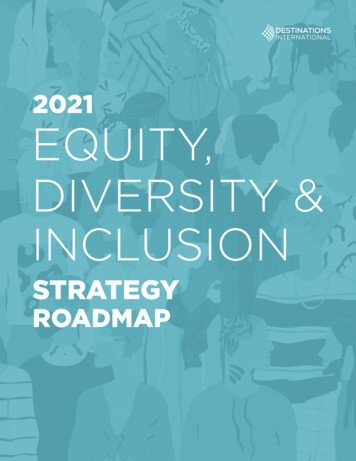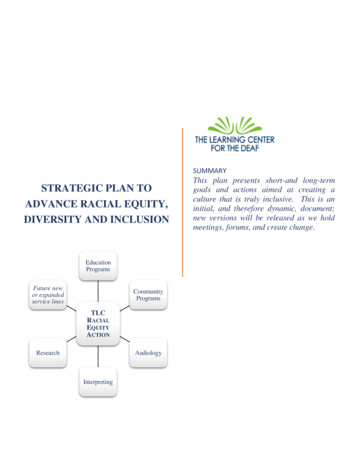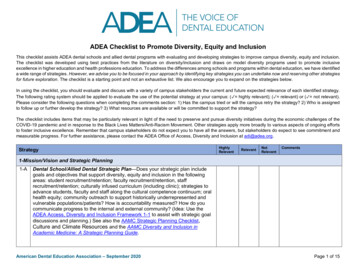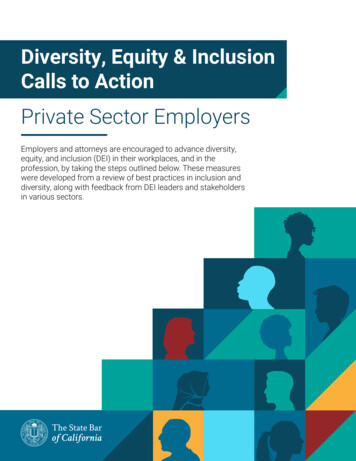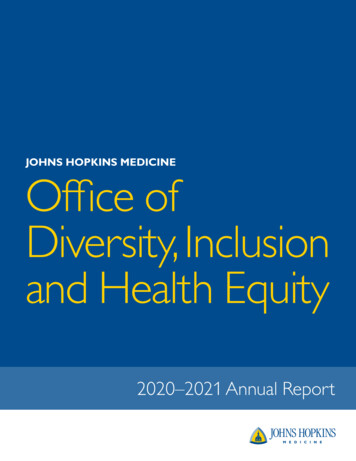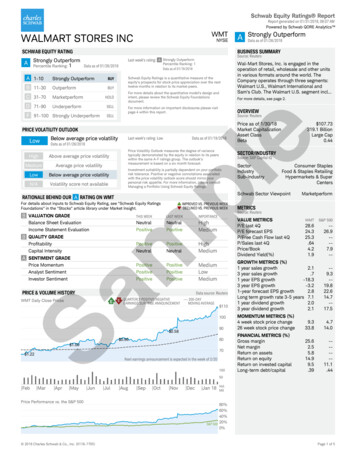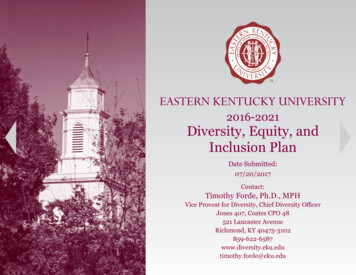
Transcription
2016-2021Diversity, Equity, andInclusion PlanDate Submitted:07/20/2017Contact:Timothy Forde, Ph.D., MPHVice Provost for Diversity, Chief Diversity OfficerJones 407, Coates CPO 48521 Lancaster AvenueRichmond, KY .forde@eku.edu1
2
Table of ContentsI.Executive Summary.4II.Introduction.5III.GraphsA. Figure 1. EKU’s Demographic Comparison.9B. Figure 2. EKU’s Students.10C. Figure 3.1. EKU’s Service Region.11D. Figure 3.2. KY Latino Population by County.12E. Figure 3.3. KY Black/African American Population by County.13F. Figure 4. EKU’s Black/African American Enrollment.14G. Figure 5. EKU’s Latino Enrollment.15H. Figure 6. EKU’s Fall 2016 Freshman Enrollment.16I. Figure 7. EKU’s Fall 2016 Freshman Diversity.17J. Figure 8. EKU’s Freshman Enrollment.18K. Figure 9. EKU’s Fast Facts.19L. Figure 10. EKU’s Workforce Diversity.20IV.Diversity Planning Process.21V.EKU Diversity, Equity, and Inclusion Plan Overview.24VI.Strategic Plan – Opportunity.25VII. Strategic Plan – Success.28VIII. Strategic Plan – Impact.33IX.Objectives: Annual Targets.38X.Conclusion and Next Steps.413
Executive Summary4The strategy for Diversity, Equity, and Inclusion Plan arisesin the context of a rich institutional history. The roots of EasternKentucky University (EKU) began in Central University, whichwas founded in 1874 after a split in the Presbyterian Churchin Kentucky. President Herman Lee Donovan led the school toreceive its first accreditation, with the Southern Association ofColleges and Secondary Schools in 1928. Through intentional,collaborative and concerted effort, we will create a more diverse,equitable, and inclusive environment for our entire campuscommunity.The Diversity, Equity, and Inclusion steering committeewas formed in the spring of 2017 and charged with articulatingrecommendations for a campus wide diversity strategic plan.Due to our institution’s demographic composition, we chose toembark on a distributed planning process where campus leaderscould make specific recommendations based on their particularneeds. Thus, campus leaders worked within their respectivecolleges to identify best strategies and initiatives that could beused to create a more diverse, equitable, and inclusive campus.We celebrate and promote diversity, equity, and inclusion in all itsforms and we are committed to creating an environment in whichideas may be freely expressed and challenged, and all personsare welcomed and respected in their academic and socialdevelopment. The plan was to focus on three areas including a)opportunity, b) success, and c) impact. A summary of each focusareas is briefly discussed below.To address opportunity, that is, maintaining a diverse studentbody, we plan to increase our enrollment by creating newnetworks, extending our outreach beyond our service area, andhosting campus visits. Additionally, we want to focus on retentionand graduation rates by using high impact learning strategiesand early warning alert systems that allow us to identify studentswho may be struggling and need support.To address success, that is, providing necessary supportsso that students can have successful college careers, we areintentionally creating committees and initiatives that specificallyfocus on the needs of URM and low income students (Pellgrant eligible as determined by Free Application for FederalStudent Aid (FAFSA)). We have already started planning waysto diversify, which include the curriculum and scholarshipsfor retention for URM students. We also want to identify andincrease funding sources and scholarships through strategicpartnerships.To address impact, that is, providing an inclusive andsupportive environment for all students, we have already startedseveral initiatives that include a) creating online professionaldevelopment courses that feature high impact learning strategiesand topics such as culturally responsive pedagogy, and b)
providing inclusive excellence workshops for faculty, staff andstudents on topics such as cultural competency, implicit bias,micro-aggressions, and cultural and identity taxation. EKU ispositioned to make significant strides in creating a more diverseinclusive environment, where all of our students are fully preparedto contribute to the success and vitality of their communities,the Commonwealth, and the world. Our Diversity, Equity, andInclusion Plan as detailed in the pages that follow will provide theblueprint to help us achieve our goals.5
Introduction6Setting and GeographyEKU, with a record-high enrollment of approximately 17,000students in 2016, is a regional, coeducational, public institution ofhigher education, offering general and liberal arts programs, preprofessional and professional preparation programs in educationand various other fields at both the undergraduate andgraduate levels.Located in picturesque Richmond, Madison County, Kentucky,Eastern has a distinguished record of more than a century ofeducational service to the Commonwealth. Richmond, the countyseat of Madison County, is one of the Commonwealth’s fastestgrowing cities, with about 33,000 residents. The communityprovides an excellent environment for the university student andboasts a Center for the Arts. Fort Boonesborough State Park,birthplace of Kentucky, is located 12 miles to the north. Manyother historical sites are within easy driving distance. Scenic andrecreational areas surround this section of the state.HistoryThe Kentucky General Assembly of 1906 enacted legislationestablishing the Eastern Kentucky State Normal School. GovernorJ.C. Beckham signed the bill into law on March 21, 1906. OnMay 7 of that year, the Normal School Commission, meetingin Louisville, selected the campus of the old Central University,founded in 1874 in Richmond, as the site of the new school. OnJune 2, 1906, Ruric Nevel Roark was chosen President of theNormal School and the training of teachers was begun.In 1922, Eastern became a four-year institution known as theEastern Kentucky State Normal School and Teachers College. Thefirst degrees were awarded by this institution in 1925. In 1928, theCollege was accredited by the Southern Association of Collegesand Secondary Schools. In 1930, the General Assembly renamedthe school the Eastern Kentucky State Teachers College.In 1935, a graduate program was approved at Eastern, leadingto the Master of Arts degree in Education. In 1948, the GeneralAssembly removed the word “Teachers” from the name ofthe college and granted the college the right to award nonprofessional degrees.The most significant day since its founding came for Eastern onFebruary 26, 1966, when Governor Edward T. Breathitt signed intolaw a bill renaming the institution Eastern Kentucky University andsanctioning the awarding of graduate degrees in academic fieldsother than education. Ever-mindful of the purpose of its founding,Eastern continues to recognize its historic function of preparingquality teachers for the elementary and secondary schools of theCommonwealth. However, a strong liberal arts curriculum leadingto appropriate degrees, together with pre-professional courses inseveral areas and graduate programs, enable Eastern to servethe Commonwealth as a regional comprehensive university.
Today, EKU offers 108 academic programs at the associate,baccalaureate and graduate levels, including four doctoralprograms, all launched since 2008: Educational Leadership andPolicy Studies (Ed.D.), Nursing (DNP), Occupational Therapy(OTD), and Clinical Psychology (Psy.D.).EKU is organized into six academic colleges: College ofBusiness and Technology, College of Education, College of HealthSciences, College of Justice and Safety, College of Letters, Artsand Social Sciences, and College of Science. In addition to itsmain campus in Richmond. Eastern maintains regional campusesin Corbin, Danville, Manchester, and Lancaster.Additionally, diverse attributes of Eastern are briefly described below.Unique Attributes EKU is one of only two institutions in Kentucky to receive the2016 Higher Education Excellence in Diversity (HEED) Awardfrom Insight into Diversity magazine. Minority Access honored EKU as an institution committed todiversity for 2016. Diversity Award, Minority Access Inc., 2013-2017, and has metall eight objectives of the Statewide Diversity Policy. More than 72% of the students attend full-time. Within thestudent body, more than 58% of the students are women andnearly 18% are minorities. Approximately 85% of the studentsare from Kentucky. The Fall 2016 freshman class was thesecond largest in Eastern Kentucky’s history, behind only theFall 2015 class, and the best ever academically preparedclass.“Make No Little Plans: A Vision for 2020”Behind every successful institution is a strategic plan thataccurately reflects its vision, mission and values; effectivelyappropriates its human, physical and financial resources; andundergrads its direction, its hopes, and its dreams. EKU has sucha plan.As the University continues to move forward, Make No LittlePlans: A Vision for 2020 focuses on six strategic goals: AcademicExcellence, Commitment to Student Success, InstitutionalDistinction, Financial Strength, Campus Revitalization, andService to Communities and Region.The best, most effective strategic plan is one driven by theaspirations of those who live and breathe it every day. EKU’snew Diversity, Equity, and Inclusion Plan is the result of thecollaborative efforts of a cross-section of the campus community:a dedicated team of faculty, staff, and students whose membersare committed to the betterment of EKU, its continued growth and,most of all, the success of all students.VisionEKU will be a premier university dedicated to innovativestudent engagement and success, advancing Kentucky, andimpacting the world.MissionAs a school of opportunity, EKU fosters personal growth andprepares students to contribute to the success and vitality oftheir communities, the Commonwealth, and the world. EKU iscommitted to access, equal opportunity, dignity, respect, andinclusion for all people, as integral to a learning environment inwhich intellectual creativity and diversity thrives.7
ValueEKU’s values shall permeate the mission and will be the fiber ofthe institution for it to achieve its vision: Intellectual vitality, characterized by knowledge, scholarlyinquiry, creativity, critical thinking, and curiosity all with a globalperspective. Sense of community, characterized by a supportiveenvironment with strong relationships and a commitmentto service, shared governance, collaboration, and unity ofpurpose. Cultural competency, characterized by equitable opportunitiesand treatment, mutual respect, and the inclusion andcelebration of diverse peoples and ideas. Stewardship of place, by which the University enhancesthe intellectual capacity, economic vitality, environmentalsustainability, and quality of life of the communities it serves. Accountability, characterized by fiscal responsibility, operationaltransparency, and responsiveness to the needs of internal andexternal stakeholders. Excellence, achieved through integrity, continuous qualityimprovement, and a focused emphasis on the personal andprofessional growth of students, faculty, and staff.For more information, visit http://www.eku.edu/.The next section provides graphs that highlight EKU’s diversestudent population and workforce.8
Figure1. Demographics:EKU VersusRegionHowDoes EKU CompareToServiceThe Demographics(Undergraduate and Graduate)And Diversity In The Service Region?6%6%5.4%5%5%4%4%3%3%2.5%2%0%-1.9% 1%1%0%2%Black/African AmericanLatinoEKU’s Service RegionOffice of Institutional Effectiveness and Research, EKU 20161%0%Black/African AmericanLatinoEKU’s Student Population*Based on EKU’s enrollment as of November 20169
Figure 2. Percent of Kentucky Residents StudentsEKU is Kentucky’s UniversityEKUKentucky’sMoreisthan85% of EKUUniversity undergraduate and graduate studentsMorethan 85%of EKU students are Kentucky residentsare Kentuckyresidents91% of Fallfreshmen90%2016of Fall 2016EKUFreshmenare “KY residents”are “KYresidents”Fall 2016EKU Total FreshmanEnrollment3,43510Office of Institutional Effectiveness and Research, EKU August 29, 2016
Figure 3.1. EKU Service Region vs. Distribution of URMPopulation in KentuckyService RegionLow-income students make up 43% of the undergraduate population, 2nd among Kentucky comprehensives.Office of Institutional Effectiveness and Research, EKU 201411
Figure 3.2. EKU Service Region vs. Distribution of URMPopulation in KentuckyKentucky County Latino PopulationsSource 2000 CensusProduced by Kentucky Population Research, University of LouisvillePercent LatinoUnder-represented minority students account for 11% of the undergraduate population, which is double the 5.2%accounted for in the 22 county service region.12Office of Institutional Effectiveness and Research, EKU 2014
Figure 3.3. EKU Service Region vs. Distribution of URMPopulation in KentuckyPercentage of Total Population as Black/African American by CountyUnder-represented minority students account for 11% of the undergraduate population, which is double the 5.2%accounted for in the 22 county service region.Office of Institutional Effectiveness and Research, EKU 201413
Figure 4. EKU’s Black/African American EnrollmentBlack/African-American Enrollment12001000800600400200014Office of Institutional Effectiveness and Research, EKU 2016
Figure 5. EKU’s Latino EnrollmentLatino Enrollment4504008006004002002002002000Office of Institutional Effectiveness and Research, EKU 201615
Fall 2016 Freshman EnrollmentFigure 6. EKU’s Fall 2016 Freshman Enrollment221335126189418391561*As of 29 6Office of Institutional Effectiveness and Research, EKU on-Kentucky
Figure 7. EKU’s Fall 2016 Undergraduate DiversityFall 2016 Freshman Diversity37 133511987921717938212,1912264American icIslanderNative AmericanNative Hawaiian/PIAfricanAmericanBlack/African AmericanOffice of Institutional Effectiveness and Research, EKU Fall 2016LatinoWhiteAsianLatinoWhite*As of 29 Aug17
Figure 8. EKU Freshman Fall 2015 to Fall 2016 Diversity rican American/Black/16215AsianAsian2131Native Hawaiian/Other85American Indian/AlaskanNative020406080100120201618246Office of Institutional Effectiveness and Research, EKU August 29, 20161401602015*Asof18029200Aug220240260
Figure 9. EKU’s Fast FactsNonresident Alien (1.68%)Asian (0.88%)Native Hawaiian/Other Pacific Islander (0.10%)Black/African American (5.79%)Two or More Races (2.26%)Office of Institutional Effectiveness and Research, EKU 2016Latino (2.33%)White (83.04%)Unknown (3.94%)19
Figure 10. EKU’s 2016 Workforce DiversityEKU’s Employees:Administrative and DeansEKU’s Full Time ed White609Tenured Minority*WhiteMinority*EKU’s Full TimeFemale Faculty9610779448282320Tenure-Track MaleMale STEM* FacultyTenure-Track FemaleFemale STEM* Faculty*Minority: Black/African American, Latino, American Indian/Alaskan Native, Native Hawaiian/Other Pacific Islander*STEM Departments include (Agriculture, Applied Engineering and Tech, Biological Sciences, Chemistry, Computer Science, Geo-sciences, Math & Statistics, Physics & AstronomyOffice of Institutional Effectiveness and Research, EKU 2016
Diversity Planning ProcessThe EKU Diversity, Equity, and Inclusion Plan is adocument which has been strategically aligned with theUniversity’s Strategic Plan, the CPE Strategic Agenda, andthe Diversity Policy. The plan is designed to prepare theuniversity community for a global society. We believe thatit is the duty of Eastern Kentucky University to promotean understanding of the benefits of higher education andsocial justice to the citizens of southeastern Kentucky, theCommonwealth of Kentucky, the nation, and the world.To facilitate the release of the plan, in the spring of 2017,the chief diversity officer convened a steering committeecomposed of campus leaders from across the campus. Weused a distributed approach where each campus leader couldidentify strategies, challenges, and opportunities from theirrespective schools. Additionally they were charged to:1. Identify and recommend practices and initiatives thatwill help create a more inclusive campus; and2. Identify the appropriate metrics to ensure accountabilityfor the objectives and strategies identified in the Diversity,Equity, and Inclusion Plan.The Diversity, Equity, and Inclusion Plan ApproachThe diversity steering committee was assembled to focuson the three areas of our diversity plan, namely, opportunity,21
success, and impact. We developed the plan in phases through an iterative process over several months. Each phase is briefly outlinedbelow: Phase I - Initial Charge - The diversity steering committee was divided into three small subcommittees based on each members’expertise and interest. Further, each subcommittee was assigned one focus area, either opportunity, success, or impact. Somecommittee members served on two subcommittees. Each subcommittee member talked to colleagues in their respective collegesand departments to identify ongoing diversity related initiatives and to brainstorm about best practices they would like to seeimplemented. Phase II - Subcommittee draft - The information from each subcommittee was drafted into one document for review by thecommittee and the chief diversity officer. Each subcommittee also had a chance to review each other’s work and note anyduplications or overlap. Finally, the subcommittee identified their top priorities. Phase III - Consensus - All subcommittees were convened to discuss and identify the top priorities to be included in the Diversity,Equity, and Inclusion Plan. Once priorities were established, the plan was then reviewed by our finance team, the provost and seniorvice president for academic affairs, and the executive vice president and general counsel.Diversity, Equity, and Inclusion Plan Steering Committee during Academic Year 2016-17 included:Dr. Ogechi AnyanwuDirector of African/African American Studies/ProfessorDr. Russell CarpenterExecutive Director of the Noel Studio for Academic Creativity/Associate ProfessorDr. Laurie CarterExecutive Vice PresidentMs. Lori Davis, J.D.Director of Equity Center for Student AccessibilityMs. Dana Fohl, J.D.University CounselDr. Timothy FordeVice Provost for Diversity and Chief Diversity OfficerMs. Joslyn Glover, J.D.Title IX Coordinator, Office of Equity and InclusionDr. Laurence HayesAssociate Dean and Interim Chair of ASLIE, College of EducationDr. Victor KappelerDean of College of Justice & Safety/Foundation ProfessorMs. Lisa Mendenhall, M.A.Assistant Director of Resident Life, Living Learning Center and RetentionDr. Brett MorrisExecutive Director of Enrollment ManagementDr. Minh NguyenAssociate Director of the Honors Program/Director of the Asian Studies Program/Coordinator of the National and22International Scholarships and Fellowships/Professor of PhilosophyDr. Shirley O’BrienProfessor/Foundation ProfessorDr. Eugene PalkaVice President for Student SuccessDr. Eric ParkerExecutive Director of Model Laboratory SchoolDr. Sheila PressleyInterim Dean of College of Health Sciences/ProfessorDr. Tanea ReedAssociate Professor of ChemistryDr. Luv’Tesha RobertsonDirector First Year Courses and Learning CommunitiesDr. Lara VanceDirector of Student Success CenterDr. Janna ViceSenior Vice President for Academic Affairs and ProvostDr. Socorro ZaragozaAssociate Professor of Languages, Cultures, & Humanities/Spanish AdvisorDr. Weiling ZhuangInterim Chair of Marketing/Associate Professor of Marketing
To support diverse populations not specifically addressed in this plan, such as non-traditional, LGBTQ, first-generation, and veteransEKU has the following initiatives: Freshman Academy; Upper Class Academy; First Colonel Program; the Alphabet Center; StudentSuccess Center; Life Skills Coach; Diversity Office Scholarship Program; and Older Wiser Learners. EKU has been ranked No. 1 or No.2 national “Best for Vets” in four of the last five years by Military Times EDGE magazine; Victory Media has placed EKU among the top“Military Friendly School” for the past six years. EKU will conduct a biannual diversity climate survey for faculty, staff, and students tomonitor the campus community environment.To attract underrepresented minority staff and faculty EKU advertises in the following diversity publications: Diverse Issues in HigherEducation; Insight into Diversity; and Latino Outlook in Education. All employee searches by EKU are expected to include diversecandidates as part of the pool of job applicants.23
EKU Diversity, Equity, and Inclusion Plan OverviewDiversity at EKU is an inextricable component of academic excellence. It is intricately interwoven into creating a culture ofpreeminence as was envisioned in our strategic plan, Make No Little Plans: A Vision for 2020. Diverse learning environments nurturehigher order critical thinking, foster civic learning and engagement, and prepare us to be productive citizens in an increasingly globaland complex society. Diversity is also rooted in our six strategic goals: Academic Excellence, Commitment to Student Success,Institutional Distinction, Financial Strength, Campus Revitalization, and Service to Communities and Region.In the table that follows, each area has identified objectives, strategies, assessment, method of assessment, and frequencyof assessment.24
Eastern Kentucky UniversityDiversity, Equity, and Inclusion PlanOpportunityMaintaining a diverse student body is an essential contribution to the educational experience of Kentucky’s postsecondary students.ObjectiveObjective 1: Increaseenrollment of Black/African Americanundergraduate studentsby 1% annuallyStrategies1.1 Design STEM-HProspective StudentDays targeting Black/African Americanstudents1.2 Create EKU campusvisits for Black/AfricanAmerican KCTCS andGateway CommunityCollege students1.3 EKU StudentOutreach and TransferOffice (SOTO), Diversityand Accessibility Officeswill meet with KCTCSand GCC centerscoordinators to share theAssessment1.1.1 Number of Black/African Americanundergraduate studentsrecruited throughSTEM-H ProspectiveStudent Days1.2.1, 1.3.1 Number ofBlack/African AmericanKCTCS and GCCtransfer studentsMethod of Assessment Frequency of Assessment1.1.1, 1.2.1, 1.3.1 Banner 1.1.1, 1.2.1, 1.3.1Information SystemEvaluate annually dataand Student Successavailability, Feb 1 (fall)Collaborative (needsubstitute)25
Opportunity26ObjectiveStrategiesAssessmentMethod of Assessment Frequency of AssessmentObjective 2: Increaseenrollment of Latinoundergraduate studentsby 3% annuallyvarious EKU programs2.1 Design STEM-HProspective StudentDays targeting Latinostudents2.2 Create EKU campusvisits for Latino KCTCSand GCC students2.3 EKU SOTO, Diversity and AccessibilityOffices will meet withKCTCS and GCC centercoordinators to share thevarious EKU programsthat align with KCTCSand GCC programs2.1.1 Number ofundergraduate Latinostudents recruitedthrough STEM-HProspective StudentDays2.2.1, 2.3.1 Numberof KCTCS and GCCtransfer Latino students2.1.1, 2.2.1, 2.3.1Banner InformationSystem and StudentSuccess Collaborative(need substitute)2.1.1, 2.2.1, 2.3.1Evaluate annually dataavailability, Feb 1 (fall)Objective 3: Increaseenrollment of URMundergraduate studentsby 2% annually3.1 Design STEM-HProspective StudentDays targeting URMstudents3.2 Create EKUcampus visits for URMKCTCS and GCCstudents; share transferinformation3.1.1 Number of URMundergraduate studentsrecruited throughSTEM-H ProspectiveStudent Days3.2.1, 3.3.1 Numberof KCTCS and GCCtransfer URM students3.1.1, 3.2.1, 3.3.1Banner InformationSystem and StudentSuccess Collaborative(need substitute)3.1.1, 3.2.1, 3.3.1Evaluate annually dataavailability, Feb 1 (fall)
OpportunityObjectiveStrategiesAssessmentMethod of Assessment Frequency of Assessment3.3 EKU SOTO, Diversityand AccessibilityOffices will meet withKCTCS and GCC centercoordinators to share thevarious EKU programsObjective 4: Increaseenrollment of URMgraduate andprofessional students by1% annually4.1 Increase targetedmarketing of EKU onlinemasters and doctoralprograms to URM adults4.1.1 Number of adultstudents admitted intoEKU online masters anddoctoral programs4.1.1 Banner InformationSystem and StudentSuccess Collaborative(need substitute)4.1.1 Evaluate annuallydata availability, Feb 1(fall)27
SuccessBecause maintaining a diverse student body is essential, institutions must commit to helping those admitted students be successfulwhen they arrive on campus.Objective28StrategiesAssessmentMethod of AssessmentFrequency of AssessmentObjective 1: Increasethe six-year graduationrate of first-time, full-timebaccalaureate degreeseeking low incomeundergraduate studentsentering in the fallsemester (or entering inthe summer and returningin the fall), who graduatewith a bachelor’s degreewithin six years from theirinstitution of entry by3.1% annually1.1 Expand currentinitiatives (FreshmanAcademy, Upper ClassAcademy, Life SkillsCoach, Diversity OfficeScholarship Program) tomentor low income, nontraditional, LGBTQ, firstgeneration and veteranundergraduate studentsand keep them on trackto graduate1.1.1 Number of lowincome undergraduatestudents whoparticipated in theinitiatives (FreshmanAcademy, Upper ClassAcademy, Life SkillsCoach, Diversity OfficeScholarship Program)who graduate within sixyears of their institutionentry1.1.1 Banner InformationSystem and StudentSuccess Collaborative(need substitute)1.1.1 Evaluate annuallydata availability, Feb 1(fall)Objective 2: Increasethe six-year graduationrate of first-time, fulltime baccalaureatedegree-seeking URMundergraduate studentsentering in the fallsemester (or entering inthe summer and returning2.1 Broaden currentdiversity initiatives(Freshman Academy,Upper Class Academy,Life Skills Coach,and Diversity OfficeScholarship Program)to mentor URM, lowincome and non-2.1.1 Number of URM,low income and nontraditional, LGBTQ, firstgeneration, and veteranundergraduate studentswho participated in theinitiatives (FreshmanAcademy, Upper ClassAcademy, Life Skills2.1.1, 2.2.1, 2.3.1, 2.4.1Banner InformationSystem and StudentSuccess Collaborative(need substitute)2.1.1, 2.2.1, 2.3.1, 2.4.1Evaluate annually dataavailability, Feb 1 (fall)
SuccessObjectivein the fall), who graduatewith a bachelor’s degreewithin six years from theirinstitution of entry by3.1% annuallyStrategiesAssessmenttraditional, LGBTQ, firstgeneration, and veteranundergraduate studentsand keep them on trackto graduate2.2 Minimize financialbarriers for URM andlow income students byproviding applicationfee waivers, specificinformation aboutfinancial aid, EKURodney Gross and TrailBlazer Scholarships, andFAFSA support2.3 Create and increasediversity scholarsupport groups withrepresentatives fromcurrent diversity initiatives2.4 Develop mini-grantsfor low income andURM students who havefinancial barriersCoach, and DiversityOffice ScholarshipProgram) and graduatewithin six years of theirinstitutional entry2.2.1, 2.4.1 Number ofstudent recipients ofapplications fee waiversand diversity scholarships2.3.1 Number of lowincome students indiversity scholar supportgroups (FreshmanAcademy, Upper ClassAcademy, Diversity OfficeScholarship Program,Rodney Gross Program,Life Skills Coach)Method of Assessment Frequency of Assessment29
SuccessObjectiveObjective 3: Increase firstto second year retentionof first-time, degreeseeking low incomestudents who return tothe institution to continuetheir studies the followingfall by 0.6% annually30StrategiesAssessment3.1 Expand existingearly warning systemto increase outreach toURMs and low incomestudents3.2 Minimize financialbarriers for URM andlow income students byproviding applicationfee waivers, specificinformation aboutfinancial aid, EKURodney Gross and TrailBlazer Scholarships, andFAFSA support3.3 Expand and createa diversity scholarsupport groups withrepresentatives fromcurrent diversity initiatives3.4 Expand the minigrants for low incomeand URM students whohave financial barriers3.1.1 Number of lowincome studentsidentified and retainedthrough early warningsystems3.2.1, 3.4.1 Number ofstudent recipients ofapplication fee waiversand diversity scholarships3.3.1 Number of lowincome students indiversity scholar supportgroups, (FreshmanAcademy, Upper ClassAcademy, Diversity OfficeScholarship Program,Rodney Gross Program,Life Skills Coach)Method of Assessment Frequency of Assessment3.1.1, 3.2.1, 3.3.1, 3.4.1Banner InformationSystem and StudentSuccess Collaborative(need substitute)3.1.1, 3.2.1, 3.3.1, 3.4.1Evaluate annually dataavailability, Feb 1 (fall)
SuccessObjectiveObjective 4:
The roots of Eastern Kentucky University (EKU) began in Central University, which . a graduate program was approved at Eastern, leading to the Master of Arts degree in Education. In 1948, the General . (Ed.D.), Nursing (DNP), Occupational Therapy (OTD), and Clinical Psychology (Psy.D.). EKU is organized into six academic colleges: College of
